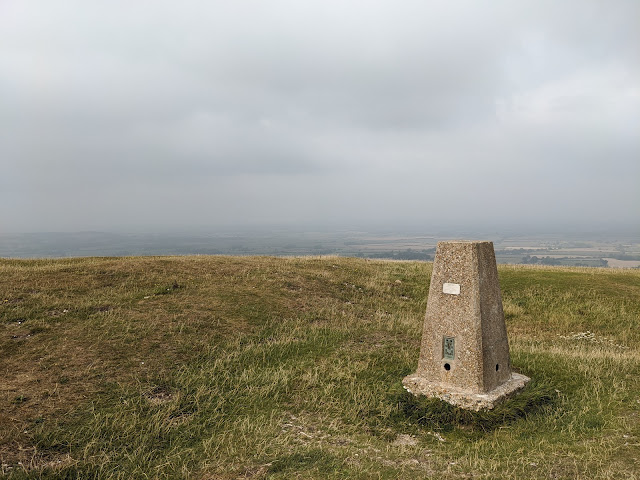South Downs: Firle Beacon
My third and final walk of my day pottering about by car in East Sussex was to Firle Beacon. I'm accustomed to walks on the South Downs starting and ending at railway stations, which are typically located at lower altitudes, so usually at some point there is an arduous but worthy climb. When, on such walks, I pass a car park atop the downs I internally tut at all the lazy people who have foregone that exertion and have just driven to the top of the hill instead. Today however that is precisely what I did!
Of the two options for lazy car parks near Firle Beacon I chose the one to the west, noting on the Ordnance Survey Map that the lane leading up to it - Firle Bostal - seemed a bit wider. Being an infrequent driver I didn't want to have to back up on a steep single track country lane.
The grey skies and haze refused to lift today, so although in better conditions the area around Firle Beacon offers spectacular views (see for example my delightful walk along there with my daughter last year - a blissful walk I often daydream about), today it was a bit limited.
I had to negotiate my way through a herd of cows, who thankfully seemed thoroughly disinterested in the walkers passing by.
I still took photos of the views on the short walk (just over a mile) from the car park to the "summit" of Firle Beacon, but let's face it with all that grey they're not particularly inspiring.
As I approached the trig point for Firle Beacon (see the top of the page for the obligatory photo), one thing I hadn't noticed on previous walks along this section of the South Downs was that there are a number of barrows here. The round barrows are probably early Bronze Age, but there's also a more prominent long barrow, apparently Neolithic. Alas it's the other side of a fence, and outside the open access land area, so I couldn't get any closer than this. Unlike Wayland's Smithy or Coldrum Long Barrow (both of which I'd visited recently) there aren't any stones showing externally, which probably explains why I'd previously just walked past it without noticing it - it isn't immediately obvious that it's a man made feature.
Local legend refers to this long barrow as the Giant's Grave, and there are tales of the giant of Firle Beacon battling with the giant of Windover Hill - which, in terms of folklore, accounts for the Long Man of Wilmington. So in hindsight this made a nice companion to my other walk earlier today.
I sat for a while atop Firle Beacon, amongst the wild flowers, to take in the view - such as it was with today's weather. It was a peaceful spot, and I pondered what the people of the Neolithic age thought of this place. Presumably the view would have changed to some extent in the intervening time - the patchwork quilt of fields we see today has replaced what was once sprawling forest.
I'm convinced at least some part of the experience would have been the same though - that feeling of rising above it all, the sense of perspective, and the way space like this provokes quiet reflection, as I was doing.
One thing is for certain. The people of the Neolithic age didn't get here by car.











Comments
Post a Comment